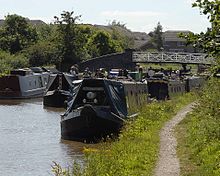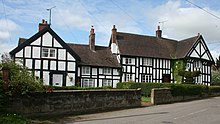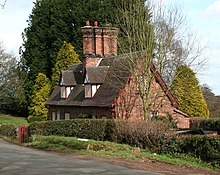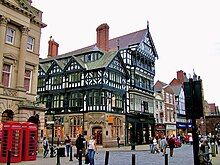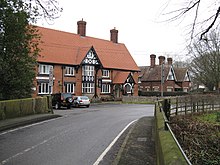Portal:Cheshire/Selected settlement/Archive
The following articles are currently featured as the Selected town or village at the Cheshire Portal. To suggest an article for inclusion, use the suggestions page
Portal:Cheshire/Selected settlement/1
Middlewich is one of the four Cheshire wich towns. Founded by the Romans under the name Salinae, it was a major Roman site of salt production, and salt manufacture remains an important local industry. Middlewich has also been known historically for silk and agriculture.
The town lies on the confluence of a number of natural and man-made features: the Rivers Dane, Croco and Wheelock; the Shropshire Union and Trent and Mersey Canals; and the A533, A54 and A530 roads. The parish church, St. Michael and All Angels, dates back to the 12th century.
In common with other towns within mid-Cheshire, the good motorway and road links have seen a large influx of people since 1970, doubling the population of Middlewich to around 14,000. Events such as the annual folk and boat festival, and the Roman and Norman festivals have helped to boost tourism in the town.
Portal:Cheshire/Selected settlement/2
Runcorn is an industrial town and cargo port in the borough of Halton. It stands on the southern bank of the River Mersey where the estuary narrows to form Runcorn Gap, spanned by the Silver Jubilee Bridge (pictured) and the Mersey Gateway. The Manchester Ship Canal runs between the town and the Mersey, and is joined by the Bridgewater Canal.
The earliest reference to the settlement is in the Anglo-Saxon Chronicle as Rumcofan, meaning "a wide cove or bay". A small, isolated village until the coming of the Industrial Revolution, various industries developed in Runcorn during the 19th century, in particular, soap and alkali manufacture, quarrying, shipbuilding, engineering and tanning. Only the chemical industry remains important, and diversification has been driven by good access to the transport network. A new town was built to the east of the existing town in the 1960s and 1970s which, together with later developments further east, has resulted in the population doubling to more than 60,000.
Portal:Cheshire/Selected settlement/3
Widnes is an industrial town on the northern bank of the River Mersey, where the estuary narrows to form the Runcorn Gap. Historically in Lancashire, it became part of Cheshire in 1974, within the borough of Halton. It had a population of a little over 60,000 in 2011.
Before the Industrial Revolution, Widnes consisted of a small number of separate settlements on predominantly marsh and moorland. In 1847, the first chemical factory was established, and the town rapidly became a major centre of the chemical industry using immigrant workers from Ireland, Poland, Lithuania and Wales. The town was described in 1888 as "the dirtiest, ugliest and most depressing town in England". Although there has been a degree of diversification of the town's industries, Widnes remains a major manufacturer of chemicals.
Spike Island (pictured), where the disused Sankey Canal terminates, has been reclaimed as a recreational area. The nearby Catalyst Science Discovery Centre is the world's first museum dedicated to the chemical industry.
Portal:Cheshire/Selected settlement/4
Bradwall is a small village and civil parish near Sandbach. The name derives from the Old English, and means "broad spring". It covers an area of 1,938 acres (7.84 km2) and had a population of 182 in 2011.
Archaeological finds include a Late Bronze Age axe head and a hoard of Roman coins. The village is not mentioned in the Domesday Book, but became known from the 13th century as the manorial estate of Richard de Bradwall and his successors, including the families of Venables, Berington and Oldfield. From the early 19th century, it became the seat of the Latham family who lived at Bradwall Hall (pictured) until its demolition in the early 20th century. Surviving historic buildings include the hall's coach-house, Bradwall Reformatory School, built by the Latham family in 1855, and the Wesleyan Methodist Church, founded in 1882.
The manufacturer of Foden Trucks and their award-winning Fodens Motor Works Band were based in the civil parish until a 1936 boundary change. The area is now predominantly agricultural, with a mix of dairy and arable. Visitor activities include coarse fishing, horse riding and eventing (horse trials).
Portal:Cheshire/Selected settlement/5
Poynton is a town on the easternmost edge of the Cheshire Plain, near Macclesfield and Stockport. The manor was first recorded in 1289. The town straddles the Red Rock Fault, which brings the Permo–Triassic sandstones and mudstones of the Cheshire Plain up against the Millstone Grit and shales of the Peak District. To the immediate east of the fault are the coal measures of the Carboniferous period. Coal was mined at Poynton from the 16th century, and its collieries were the largest in Cheshire. Anson Engine Museum, on the site of a former colliery, has a collection of stationary engines.
Consequent urbanisation and socioeconomic development necessitated better transport links; these came with the completion of the Macclesfield Canal through the town in 1831, and the arrival of the Manchester and Birmingham Railway in 1845 and the Macclesfield, Bollington and Marple Railway in 1869. The collieries closed in 1935. The population has nearly trebled since 1945, to over 14,000 in 2011. In the late 20th century, Poynton became a commuter town for Manchester.
Portal:Cheshire/Selected settlement/6
Marbury is a small village near Whitchurch, in the civil parish of Marbury cum Quoisley, which borders Shropshire. The parish covers 2,168 acres (877 ha); it includes the small settlements of Hollins Lane, Marley Green, Quoisley, and part of Hollyhurst, Willeymoor and Combermere Abbey park, with a population just under 250 in 2001.
Marbury is thought to have been inhabited since the Anglo-Saxon period. In the Civil War, the parish was plundered by both sides during 1642–44, after Thomas Marbury declared for Parliament. It contains many historic buildings, the earliest being the 15th-century St Michael's Church. The area is agricultural with undulating terrain, 75–120 metres in elevation. Dairy farming is the main industry. The Llangollen Canal runs along the northern boundary, and five meres form important wildlife habitats. Marbury Big Mere is a fishing lake and the Quoisley Meres are a Wetland of International Importance; they originate in glacial kettle holes. "Marbury Merry Days", a traditional country fair, is held in May.
Portal:Cheshire/Selected settlement/7
Peckforton is a scattered settlement and civil parish covering 1,754 acres (710 ha), near Malpas. The population was around 150 in 2006. The Peckforton Hills form the western part of the parish, with high points at Peckforton Point and Stanner Nab (around 200 metres). They are the source of the Weaver and Gowy rivers. Part of Peckforton Woods, largely planted in 1922, form a Site of Special Scientific Interest.
The hills have been quarried since the Roman era. Peckforton appears in the Domesday survey of 1086. The area is predominantly agricultural. The earliest surviving buildings date from the early 17th century. Peckforton and the adjacent Beeston were part of an estate purchased by John Tollemache in 1840. He had Peckforton Castle – a mansion designed by Anthony Salvin in imitation of a medieval castle – built at the northern end of the Peckforton ridge. A local stone mason carved an elephant bearing a castle in red sandstone from the same quarry. Many of the local buildings were constructed for Tollemache using brick in the 1860s and 1870s.
Portal:Cheshire/Selected settlement/8
Sound is a small settlement and civil parish near Nantwich. The parish covers 1,089 acres (441 ha) and also includes Newtown and Sound Heath, with a total population of around 240 in 2011. The name is of Saxon origin and means "a sandy place". The first record of the township is in 1310. It was raided by Royalist forces in 1643, during the Civil War. The Methodist chapel was built in 1838, and a primary school on the boundary with Broomhall opened in 1876. Other historic buildings include a rare example of a malt kiln.
The area is mainly agricultural, with dairy farming predominating. The flat terrain has an average elevation of around 60 metres. The River Weaver runs along the southern boundary and the Welsh Marches railway line crosses the parish. Sound Heath, a Site of Special Scientific Interest and Local Nature Reserve, is an important habitat for freshwater invertebrates and breeding birds. Nationally scarce species observed here include the mud snail, great raft spider, a species of water scavenger beetle and the beautiful snout moth.
Portal:Cheshire/Selected settlement/9
Acton is a small village and civil parish lying immediately west of Nantwich. The civil parish covers 762 acres (3.08 km2) and also includes Dorfold and part of Burford, with an estimated population of 340 in 2006. The area is agricultural, with dairy farming the main industry.
The parish is believed to have been inhabited since the 8th or 9th century. Acton appears in the Domesday Book of 1086, when it was one of the wealthiest townships in the Nantwich Hundred, being valued for the same sum as Nantwich. The name means "oak town", referring to the pedunculate oaks that predominated in the adjacent Forest of Mondrem. During the Civil War, the village was taken by siege several times. The Shropshire Union Canal reached the parish in 1835, using a long embankment to avoid Dorfold Park. The parish contains many historic buildings, notably Dorfold Hall, considered by Nikolaus Pevsner to be one of the two finest Jacobean houses in Cheshire, and St Mary's Church, whose 13th-century tower is among the earliest in the county.
Portal:Cheshire/Selected settlement/10
Sandbach is a market town and civil parish near Crewe. The town is Cheshire East Council's administrative centre. The civil parish covers 10.7 km2 (4.1 sq mi), and also contains Elworth, Ettiley Heath and Wheelock villages, with a total population of nearly 18,000 in 2011.
The name derives from the Anglo-Saxon and means "sand stream" or "sand valley". There are traces of Saxon settlement and two Saxon crosses, believed to have been completed by the 9th century, stand in the market square. Sandbach appears in the Domesday Book of 1086. It has been a market town since 1579. Sandbach School was founded in 1677. The population increased during the 19th century, when the town was engaged in the silk industry. In the 20th century, Sandbach was the site of Foden and ERF lorries, and remains known for Foden's Brass Band.
The parish's many listed buildings include Old Hall Hotel and other former coaching inns, as well as several buildings by George Gilbert Scott. Sandbach Flashes, fourteen pools created by subsidence due to underlying salt deposits, form an important wildlife habitat.
Portal:Cheshire/Selected settlement/11
Chester is a city on the River Dee, near the border with Wales. It is the second-largest settlement in Cheshire after Warrington, with a population of nearly 80,000 in 2011, and as of 2019 serves as Cheshire West and Chester's administrative headquarters.
It was founded as the Roman fort of Deva Victrix in 79 AD, one of the main army camps in Roman Britain, and later a major civilian settlement. In 689, Æthelred of Mercia founded a minster church, later the first cathedral, and the Saxons improved the walls to protect against the Danes. Chester was one of the last places in England to fall to the Normans. A castle was built to dominate both the town and the Welsh border. City status was granted in 1541.
Chester is among the best-preserved walled cities in Britain, with its walls almost complete, and several surviving medieval buildings. The Industrial Revolution brought railways, canals and new roads. Substantial Victorian development included the town hall and Grosvenor Museum, as well as the many Black-and-white Revival buildings in the centre. Tourism, shops and financial services are important to the modern economy.
Portal:Cheshire/Selected settlement/12
Northwich, the most northerly of Cheshire's wich towns, lies at the confluence of the rivers Weaver and Dane, near Winsford, in the heart of the Cheshire Plain. The population of the civil parish was nearly 20,000 in 2011.
Northwich rests on Lower Keuper saliferous beds. The settlement – then called Condate, thought to mean "confluence" – has been known since the Roman era, when it was important as a river crossing and a source of salt, and the area has long been exploited for its salt pans. The town has had a market since at least 1535. From the 19th century, pumped water was used to extract salt as brine, leading to subsidence problems and the creation of flashes. Several buildings were designed to be lifted in the event of subsidence. Northwich has been involved in the chemical industry since 1874, when Brunner Mond, later part of ICI, started to manufacture soda ash in Winnington. The mines were stabilised in the early 2000s, and much of the industrial area has been reclaimed to form Northwich Woodlands. The Weaver Hall Museum documents the town's salt industry.
Portal:Cheshire/Selected settlement/13
Warrington stands at the lowest bridging point of the River Mersey. Historically within Lancashire, it became part of Cheshire in 1974. With an estimated population of around 210,000 in 2019, it is the county's largest town. The Warrington unitary authority also encompasses 18 civil parishes.
The site has been an important crossing place on the Mersey since prehistoric times. A large Roman industrial settlement centred on modern Wilderspool stood on the south bank. It declined after the end of the 2nd century, and a Saxon settlement was established on the north bank, recorded in the Domesday Survey as Walintune. By the Middle Ages, it had emerged as a market town. Warrington's expansion and urbanisation coincided with the Industrial Revolution, particularly after the Mersey was made navigable in the 18th century. In the 19th century, industries included wire drawing, textiles, brewing, tanning and soap manufacture. Further growth occurred after it was designated a new town in 1968. An IRA bomb attack in the centre in 1993 killed two children. Several medieval churches survive, and the town has a museum and art gallery.
Portal:Cheshire/Selected settlement/14
Warmingham is a village and civil parish on the River Wheelock, near the towns of Crewe, Middlewich and Sandbach. The parish had a population of just under 250 in 2011.
The land is mentioned in the Domesday Book of 1086, with a village being documented from the 13th century. The oldest surviving building dates from the late 16th century. In the 17th and 18th centuries the parish had a finery forge, which was among the earliest in the county. The area is agricultural, with dairy farming the predominant land use. The Northwich Halite Formation, a Triassic salt field, underlies the parish, and there is a long history of local salt production, with the Warmingham brine field remaining an important source of the mineral. Cavities in the salt-bearing stratum are used to store natural gas. Several flashes were created in the 20th century by subsidence after natural brine pumping in the area, some of which form part of a Site of Special Scientific Interest. The village maintains the tradition of holding a wake each May.
Portal:Cheshire/Selected settlement/15
Macclesfield is a market town on the River Bollin, in the east of the county on the edge of the Cheshire Plain, with Macclesfield Forest to its east. The population in 2011 was somewhat over 50,000.
Before the Norman Conquest, the manor was held by Edwin, Earl of Mercia and was assessed at £8. It is recorded in the Domesday Book as "Maclesfeld", meaning "Maccel's open country". The medieval town grew up on the hilltop around what is now St Michael's Church. It was granted a charter by the future Edward I in 1261. Macclesfield Grammar School was founded in 1502. The town had a silk-button industry from at least the middle of the 17th century, and became a major silk-manufacturing centre from the mid-18th century. The Macclesfield Canal was constructed in 1826–31. Hovis breadmakers were another Victorian employer (former mill pictured). Modern industries include pharmaceuticals. Multiple mill buildings are still standing, and several of the town's museums explore the local silk industry. Other landmarks include Georgian buildings such as the Town Hall and former Sunday School; St Alban's Church, designed by Augustus Pugin; and the Arighi Bianchi furniture shop.
Portal:Cheshire/Selected settlement/16
Portal:Cheshire/Selected settlement/16
Portal:Cheshire/Selected settlement/17
Portal:Cheshire/Selected settlement/17
Portal:Cheshire/Selected settlement/18
Portal:Cheshire/Selected settlement/18
Portal:Cheshire/Selected settlement/19
Portal:Cheshire/Selected settlement/19
Portal:Cheshire/Selected settlement/20
Portal:Cheshire/Selected settlement/20

